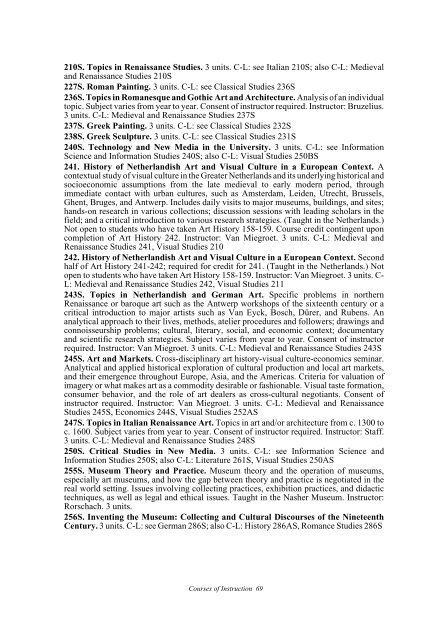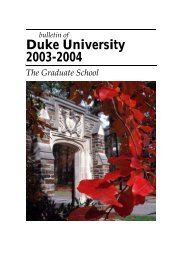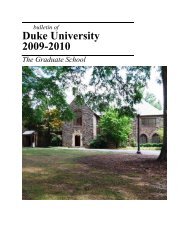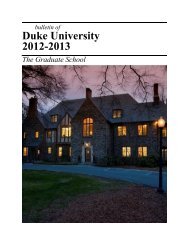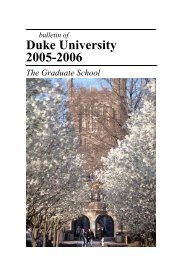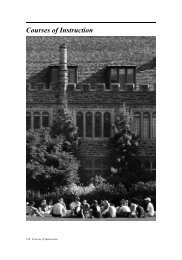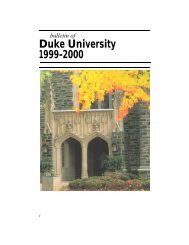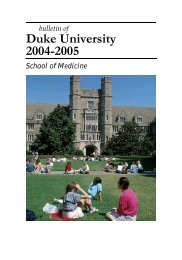Duke University 2008-2009 - Office of the Registrar - Duke University
Duke University 2008-2009 - Office of the Registrar - Duke University
Duke University 2008-2009 - Office of the Registrar - Duke University
You also want an ePaper? Increase the reach of your titles
YUMPU automatically turns print PDFs into web optimized ePapers that Google loves.
210S. Topics in Renaissance Studies. 3 units. C-L: see Italian 210S; also C-L: Medieval<br />
and Renaissance Studies 210S<br />
227S. Roman Painting. 3 units. C-L: see Classical Studies 236S<br />
236S. Topics in Romanesque and Gothic Art and Architecture. Analysis <strong>of</strong> an individual<br />
topic. Subject varies from year to year. Consent <strong>of</strong> instructor required. Instructor: Bruzelius.<br />
3 units. C-L: Medieval and Renaissance Studies 237S<br />
237S. Greek Painting. 3 units. C-L: see Classical Studies 232S<br />
238S. Greek Sculpture. 3 units. C-L: see Classical Studies 231S<br />
240S. Technology and New Media in <strong>the</strong> <strong>University</strong>. 3 units. C-L: see Information<br />
Science and Information Studies 240S; also C-L: Visual Studies 250BS<br />
241. History <strong>of</strong> Ne<strong>the</strong>rlandish Art and Visual Culture in a European Context. A<br />
contextual study <strong>of</strong> visual culture in <strong>the</strong> Greater Ne<strong>the</strong>rlands and its underlying historical and<br />
socioeconomic assumptions from <strong>the</strong> late medieval to early modern period, through<br />
immediate contact with urban cultures, such as Amsterdam, Leiden, Utrecht, Brussels,<br />
Ghent, Bruges, and Antwerp. Includes daily visits to major museums, buildings, and sites;<br />
hands-on research in various collections; discussion sessions with leading scholars in <strong>the</strong><br />
field; and a critical introduction to various research strategies. (Taught in <strong>the</strong> Ne<strong>the</strong>rlands.)<br />
Not open to students who have taken Art History 158-159. Course credit contingent upon<br />
completion <strong>of</strong> Art History 242. Instructor: Van Miegroet. 3 units. C-L: Medieval and<br />
Renaissance Studies 241, Visual Studies 210<br />
242. History <strong>of</strong> Ne<strong>the</strong>rlandish Art and Visual Culture in a European Context. Second<br />
half <strong>of</strong> Art History 241-242; required for credit for 241. (Taught in <strong>the</strong> Ne<strong>the</strong>rlands.) Not<br />
open to students who have taken Art History 158-159. Instructor: Van Miegroet. 3 units. C-<br />
L: Medieval and Renaissance Studies 242, Visual Studies 211<br />
243S. Topics in Ne<strong>the</strong>rlandish and German Art. Specific problems in nor<strong>the</strong>rn<br />
Renaissance or baroque art such as <strong>the</strong> Antwerp workshops <strong>of</strong> <strong>the</strong> sixteenth century or a<br />
critical introduction to major artists such as Van Eyck, Bosch, Dürer, and Rubens. An<br />
analytical approach to <strong>the</strong>ir lives, methods, atelier procedures and followers; drawings and<br />
connoisseurship problems; cultural, literary, social, and economic context; documentary<br />
and scientific research strategies. Subject varies from year to year. Consent <strong>of</strong> instructor<br />
required. Instructor: Van Miegroet. 3 units. C-L: Medieval and Renaissance Studies 243S<br />
245S. Art and Markets. Cross-disciplinary art history-visual culture-economics seminar.<br />
Analytical and applied historical exploration <strong>of</strong> cultural production and local art markets,<br />
and <strong>the</strong>ir emergence throughout Europe, Asia, and <strong>the</strong> Americas. Criteria for valuation <strong>of</strong><br />
imagery or what makes art as a commodity desirable or fashionable. Visual taste formation,<br />
consumer behavior, and <strong>the</strong> role <strong>of</strong> art dealers as cross-cultural negotiants. Consent <strong>of</strong><br />
instructor required. Instructor: Van Miegroet. 3 units. C-L: Medieval and Renaissance<br />
Studies 245S, Economics 244S, Visual Studies 252AS<br />
247S. Topics in Italian Renaissance Art. Topics in art and/or architecture from c. 1300 to<br />
c. 1600. Subject varies from year to year. Consent <strong>of</strong> instructor required. Instructor: Staff.<br />
3 units. C-L: Medieval and Renaissance Studies 248S<br />
250S. Critical Studies in New Media. 3 units. C-L: see Information Science and<br />
Information Studies 250S; also C-L: Literature 261S, Visual Studies 250AS<br />
255S. Museum Theory and Practice. Museum <strong>the</strong>ory and <strong>the</strong> operation <strong>of</strong> museums,<br />
especially art museums, and how <strong>the</strong> gap between <strong>the</strong>ory and practice is negotiated in <strong>the</strong><br />
real world setting. Issues involving collecting practices, exhibition practices, and didactic<br />
techniques, as well as legal and ethical issues. Taught in <strong>the</strong> Nasher Museum. Instructor:<br />
Rorschach. 3 units.<br />
256S. Inventing <strong>the</strong> Museum: Collecting and Cultural Discourses <strong>of</strong> <strong>the</strong> Nineteenth<br />
Century. 3 units. C-L: see German 286S; also C-L: History 286AS, Romance Studies 286S<br />
Courses <strong>of</strong> Instruction 69


